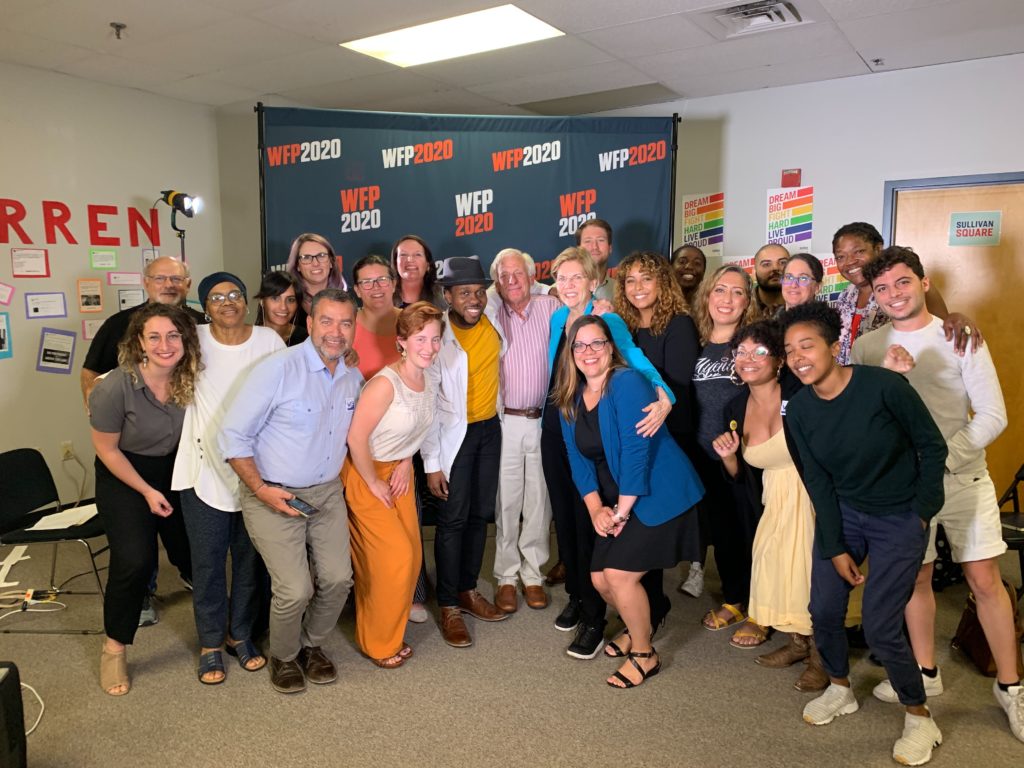I supported Bernie Sanders in 2016, and I support him now. I think his platform is the best; he has been able to move the entire field to the left; and his campaign is mobilizing tens of thousands of people – especially young people – who are energized and active. I’ve never seen anything like this for a presidential campaign in my lifetime.
At the same time, I think the critiques of the Working Families Party’s Warren endorsement are misguided. Bernie is great but he has weaknesses and groups like the Working Families Party (WFP) are partly responding to those weaknesses. Second, in making this endorsement, the WFP is doing what it was set up to do.
The endorsement process was fair
First, contrary to some claims, the endorsement was not a rigged outcome. The WFP followed a democratic process that made space for individuals, organizations, and state delegates (who themselves are a mix of individual activists and organizational representatives in states where WFP is active) to vote. States and organizations could even choose to split their votes or vote for the Party to abstain from endorsing in the primary. The outcome of that process was a Warren endorsement.
Some critics also claim that the unions, state parties and delegates controlled the outcome at the expense of individual members. But note that individual members had 50% of the vote, which is more than they had in the 2016 primary. (In 2016, the individual membership got 1/8th of the votes – about 12%.) This reflects a larger strategic shift led by WFP’s new National Director Maurice Mitchell, to base-building and individual leadership. In the past, the WFP was primarily a coalition of institutions and at times it had been held hostage to them (such as when New York unions and community groups pushed the party to endorse Cuomo). The Party needs these organizations, but an institution-only model is limited. In the year since Maurice arrived, WFP has been working to build its rank-and-file membership and to engage a grassroots base. But there is no inherently clear way to weight the votes of state and local chapters, organizational partners, movement leaders, and members. There is no magic formula here; no reason why democracy mandates a certain way to vote or weight votes.
We need a Party
Many critics argue that Bernie has the best chance to beat Trump. That may be, or it may not be. But defeating Trumpism is about more than just defeating Trump. We need a party that will be able to contend for a whole host of offices, and hold politicians accountable once in office. We need to build a party that is not candidate-centered, and the fate of the party can’t focus on individual endorsements.
In the end, whether you like the WFP or not, they are doing exactly what they were set up to do. They are attempting to build an independent, multi-racial, effective political party against all odds inside a two-party system. The challenges they face are real and complex, and if it isn’t the WFP, other left forces will need to figure out how to do it. A left party will need large organizations and unions as members, and it will need a base of grassroots members. It will need to figure out how to balance these voices, have democratic internal debate and stick together through contentious decisions.
This has already proven to be extremely difficult for the WFP and they’ve lost quite a few key organizational allies in recent years for their endorsements. For example, in 2016 the New York Times quoted a union leader who said “that he believed party officials had “‘rigged the system to make sure it went for Bernie’.” In 2018, long-time WFP allies CWA and SEIU 32BJ left after Cuomo pressured them in retaliation for prior WFP primary challenges. But the WFP has persisted, didn’t cave to organizational pressure, and dug in. They are working to figure out party- building for the long term.
Bernie isn’t perfect
Bernie is great, but he is not flawless. His support among black voters is rising, but he still hasn’t quite figured out how to bring in race and gender-based demands/movements. WFP is more committed to these movements, and it should not be assumed that there is a direct line from those commitments to a Bernie endorsement.The Warren campaign is arguably more eager to connect on these fronts, and in that way, a WFP-Warren partnership makes some organizing sense. The Crowley/Ocasio-Cortez endorsement was a bad call and they learned from it. They provided heavy support for a number of women of color candidates running in 2016 and since then.
In addition, Bernie hasn’t had the best record on working to build organizations and parties. Many Vermont progressives lament that he wasn’t part of building parties there. And after the WFP endorsed Bernie in 2016 (their first foray into presidential politics) they found that Bernie wasn’t a reliably solid ally. The Bernie campaign built the Bernie campaign (and then Our Revolution) and was reluctant to deeply partner with the WFP, share lists, arrange campaign events together. Despite endorsing Bernie and working hard on his 2016 run, Bernie did not reciprocate by helping to build the WFP. Perhaps the WFP isn’t the Party he wants to build, but we as the left need an independent party and ideally we want politicians that are working to build that.
Bernie or Bust
For the record, I also think Democratic Socialists of America (DSA) made the right decision when it voted for “Bernie or Bust” at its summer convention. Again, the point is not only to engage in the presidential race but to build an organization. It makes no sense for an organization working to build democratic socialism to endorse any candidate but Bernie. And if Bernie doesn’t win the primary there is no reason the entire organization can’t still knock on doors canvassing for Medicare for All and the Green New Deal, as well as local and state candidates their chapters might support. This work certainly builds any anti-Trump campaign AND it builds the organization. In passing the “Bernie or Bust” resolution DSA is doing what they do: building a socialist organization. Just as in endorsing Warren, the WFP is doing what they do: building an electoral coalition that is trying to push Democrats to the left and eventually become an independent party.
The long fight ahead
2020 will be a historic election. But we are in for a long fight. And if we want any chance of defeating Trumpism, as well as the anti-Trump conservatives, and the mainstream Democratic Party, we will need large, powerful and effective left organizations and political parties.
Did you enjoy this article?
We're in the middle of our annual fund drive, and this year we're building our own internal infrastructure for subscriptions, meaning more of every dollar pledged goes to fulfilling our mission. Subscribe today to support our work and be a part of Convergence's next evolution.

